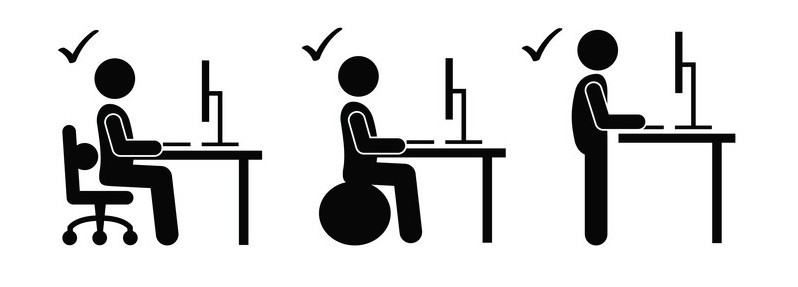How much time do you spend sitting? If you work in an office, chances are it’s an average of around 11 hours a day and that most of your time spent sitting happens at work.
By now, you’ve probably heard that spending too much time sitting isn’t great for your health. Too much sedentary time may increase the risk of heart disease, diabetes, cancer, and overall mortality. Making an effort to move more throughout the day may lower your cancer risk and improve your overall health.
In order to help their employees sit less, some employers have installed special desks that can be raised or lowered so that workers have the option to sit or stand. But in order for sit-stand desks to work, employees must use them.
A recent study published in the International Journal of Epidemiology suggests strategies that offices can use to make sure investments in sit-stand desks pay off.
 The study took place in Denmark and Greenland at offices where workers already had sit-stand desks. Despite having these desks, the workers rarely stood at work. Instead, they spent more than 70% of their day (close to 6 hours) sitting.
The study took place in Denmark and Greenland at offices where workers already had sit-stand desks. Despite having these desks, the workers rarely stood at work. Instead, they spent more than 70% of their day (close to 6 hours) sitting.
To change that, researchers designed and implemented an intervention that included multiple strategies designed to reduce sitting time at four workplaces with a total of 317 employees. Within each workplace, half of the offices received the intervention and the other half served as a control. Participants wore a device that measured movement.
After one month, employees in the intervention offices spent 71 fewer minutes per day sitting compared to control office employees. They also decreased how often they spent more than 30 minutes at a time sitting and increased how often they stood. After 3 months, the differences were not as large, but intervention employees still spent significantly less time sitting per day and had fewer long sitting periods.
Additionally, intervention employees did not cut back on their physical activity outside of work despite taking slightly mores steps during the workday. These employees lowered their percent body fat by 0.61 percentage points compared to the control group, mostly due to an increase in muscle mass. This is significant because excess body fat is a risk factor for many chronic diseases, including 11 types of cancer.
There is also good news for employers who are concerned about the downsides of promoting more standing and walking in the workplace, such as injuries or reduced performance. Only about 8% of intervention employees reported increased noise in the office and less than 6% reported other negative effects such as pain, decreased productivity, and lower quality meetings.
If you’re interested in trying this at your workplace, some of the key strategies the study included are:
- Design your workplace to encourage less sitting. In addition to the sit-stand desks that were already available for each employee, offices installed high meeting tables intended for standing meetings and identified routes employees could take for walking meetings. This made staying active during meetings a no-brainer for employees.
- Get management support. Management buy-in was critical because managers served as role models and helped secure funding for workplace improvements, such as high meeting tables.
- Involve your employees. The intervention included a 2-hour workshop where employees discussed practical strategies that they could use to stand and walk more throughout the day. Employees also set individual goals and collaborated on office-wide goals. This allowed each office to come up with customized strategies and goals tailored to their needs.
- Keep enthusiasm high. Each office appointed an ambassador whose job was to make sure common goals were discussed often so they would stay top of mind. Emails and text messages were sent twice a week to employees who opted in, helping to remind them of the key strategies discussed in the workshop.
If you’re interesting in more tips for making sit-stand desks work for you, check out this post where AICR employees share what they learned after the organization installed sit-stand desks last year.
This study was funded by Tryg Fonden, a Danish foundation.






This is a nice study and those are good points. To be honest, it is really difficult to change your working habits right away, especially if you’re using a standing desk. I myself struggled for the first few months of using it. My first time of using it was I can only stand up, up to 5 minutes only and then will go back to sitting for most of the time, lol… Good thing though that there are now key strategies wherein a company can integrate this to help their employees have a healthy and well-balance working lifestyle.